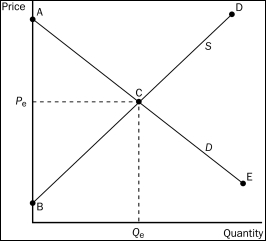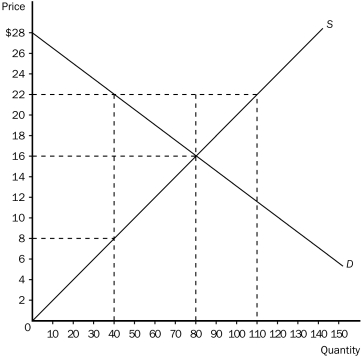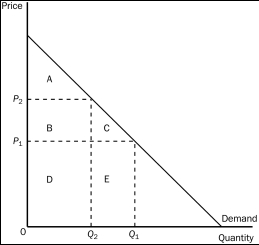A) $700
B) $2,300
C) $3,000
D) $3,700
F) All of the above
Correct Answer

verified
B
Correct Answer
verified
True/False
Total surplus in a market can be measured as the area below the supply curve plus the area above the demand curve,up to the point of equilibrium.
B) False
Correct Answer

verified
Correct Answer
verified
Multiple Choice
Figure 7-8
 -Refer to Figure 7-8.Buyers who value this good more than price are represented by which line segment?
-Refer to Figure 7-8.Buyers who value this good more than price are represented by which line segment?
A) AC.
B) CE.
C) BC.
D) CD.
F) B) and D)
Correct Answer

verified
Correct Answer
verified
Multiple Choice
Consumer surplus
A) is the amount of a good that a consumer can buy at a price below equilibrium price.
B) is the difference between the amount that a consumer actually pays for a good and the amount that the consumer is willing to pay for the good.
C) is the number of consumers who are excluded from a market because of scarcity.
D) measures how much a buyer values a good.
F) B) and D)
Correct Answer

verified
Correct Answer
verified
Multiple Choice
Noah drinks Dr.Pepper.He can buy as many cans of Dr.Pepper as he wishes at a price of $0.50 per can.On a particular day,he is willing to pay $0.95 for the first can,$0.80 for the second can,$0.60 for the third can,and $0.40 for the fourth can.Assume Noah is rational in deciding how many cans to buy.His consumer surplus is
A) $0.50.
B) $0.85.
C) $1.05.
D) $1.20.
F) A) and B)
Correct Answer

verified
Correct Answer
verified
Multiple Choice
Suppose that the equilibrium price in the market for widgets is $5.If a law reduced the maximum legal price for widgets to $4,
A) any possible increase in consumer surplus would be larger than the loss of producer surplus.
B) any possible increase in consumer surplus would be smaller than the loss of producer surplus.
C) the resulting increase in producer surplus would be larger than any possible loss of consumer surplus.
D) the resulting increase in producer surplus would be smaller than any possible loss of consumer surplus.
F) A) and C)
Correct Answer

verified
Correct Answer
verified
Multiple Choice
Figure 7-9
 -Refer to Figure 7-9.At the equilibrium price,total surplus is
-Refer to Figure 7-9.At the equilibrium price,total surplus is
A) $480.
B) $640.
C) $1,120.
D) $1,280.
F) All of the above
Correct Answer

verified
Correct Answer
verified
Multiple Choice
The "invisible hand" is
A) used to describe the welfare system in the United States.
B) a concept developed by Adam Smith to describe the virtues of free markets.
C) a concept used by J.M.Keynes to describe the role of government in guiding the allocation of resources in the economy.
D) a term used by some economists to characterize the role of government in an economy-- inevitable but invisible.
F) A) and C)
Correct Answer

verified
Correct Answer
verified
True/False
Consumer surplus is the amount a buyer actually has to pay for a good minus the amount the buyer is willing to pay for it.
B) False
Correct Answer

verified
Correct Answer
verified
Multiple Choice
Consumer surplus
A) is a concept that helps us make normative statements about the desirability of market outcomes.
B) is represented on a graph by the area below the demand curve and above the price.
C) is a good measure of economic welfare if buyers' preferences are the primary concern.
D) All of the above are correct.
F) All of the above
Correct Answer

verified
Correct Answer
verified
Multiple Choice
Figure 7-9
 -Refer to Figure 7-9.Assume demand increases and as a result,equilibrium price increases to $22 and equilibrium quantity increases to 110.The increase in producer surplus due to new producers entering the market would be equal to
-Refer to Figure 7-9.Assume demand increases and as a result,equilibrium price increases to $22 and equilibrium quantity increases to 110.The increase in producer surplus due to new producers entering the market would be equal to
A) $90.
B) $210.
C) $360.
D) $480.
F) All of the above
Correct Answer

verified
Correct Answer
verified
Multiple Choice
A supply curve can be used to measure producer surplus because it reflects
A) the actions of sellers.
B) quantity supplied.
C) sellers' costs.
D) the amount that will be purchased by consumers in the market.
F) A) and C)
Correct Answer

verified
Correct Answer
verified
Multiple Choice
Chad is willing to pay $5.00 to get his first cup of morning latté;he is willing to pay $4.50 for a second cup.He buys his first cup from a vendor selling latté for $3.75 per cup.He returns to that vendor later in the morning to find that the vendor has increased her price to $3.90 per cup.Chad buys a second cup.Which of the following statements is correct?
A) Chad's willingness to pay for his second cup of latté was smaller than his willingness to pay for his first cup of latté.
B) Chad's consumer surplus on his second cup of latté was larger than his consumer surplus on his first cup of latté.
C) Chad is irrational in that he is willing to pay a different price for his second cup of latté than what he is willing to pay for his first cup of latté.
D) Chad places a higher value on his second cup of latté than on his first cup of latté.
F) B) and C)
Correct Answer

verified
Correct Answer
verified
Multiple Choice
A seller is willing to sell a product only if the seller receives a price that is at least as great as
A) the seller's producer surplus.
B) the sellers's cost of production.
C) the seller's profit.
D) the average willingness to pay of buyers of the product.
F) B) and D)
Correct Answer

verified
Correct Answer
verified
True/False
Joel has a 1966 Mustang,which he sells to Susie,an avid car collector.Susie is pleased since she paid $8,000 for the car but would have been willing to pay $11,000 for the car.Susie's consumer surplus is $2,000.
B) False
Correct Answer

verified
Correct Answer
verified
Multiple Choice
Table 7-1
 -Refer to Table 7-1.If the table represents the willingness to pay of four buyers and the price of the product is $30,then their total consumer surplus is
-Refer to Table 7-1.If the table represents the willingness to pay of four buyers and the price of the product is $30,then their total consumer surplus is
A) $-10.
B) $-6.
C) $20.
D) $30.
F) A) and D)
Correct Answer

verified
C
Correct Answer
verified
Essay
Answer each of the following questions about supply and producer surplus. a.What is producer surplus, and how is it measured? b.What is the relationship between the cost to sellers and the supply curve? c.Other things equal, what happens to producer surplus when the price of a good rises? Illustrate your answer on a supply curve.
Correct Answer

verified
a. Producer surplus measures the benefit to sellers of participating in a market.It is measured as the amount a seller is paid minus the cost of production.For an individual sale,producer surplus is measured as the difference between the market price and the cost of production,as shown on the supply curve.For the market,total producer surplus is measured as the area above the supply curve and below the market price,between the origin and the quantity sold.
b. Because the supply curve shows the minimum amount sellers are willing to accept for a given quantity,the supply curve represents the cost of the marginal seller.
c. When the price of a good rises,producer surplus increases for two reasons.First,those sellers who were already selling the good have an increase in producer surplus because the price they receive is higher (area A).Second,new sellers will enter the market because the price of the good is now higher than their willingness to sell (area B);hence,there is additional producer surplus generated from their sales.The graph should show that as price rises from P₁ to P₂,producer surplus increases from area C to area A + B + C.
11ea43b2_bca3_4df0_a27f_f141794a89fd_TB2178_00
Correct Answer
verified
Multiple Choice
Table 7-3
For each of three potential buyers of oranges, the table displays the willingness to pay for the first three oranges of the day. Assume Alex, Barb, and Carlos are the only three buyers of oranges, and only three oranges can be supplied per day.
 -Refer to Table 7-3.Who experiences the largest gain in consumer surplus when the price of an orange decreases from $1.05 to $0.75?
-Refer to Table 7-3.Who experiences the largest gain in consumer surplus when the price of an orange decreases from $1.05 to $0.75?
A) Alex
B) Barb
C) Carlos
D) Alex and Barb experience the same gain in consumer surplus, and Carlos's gain is zero.
F) All of the above
Correct Answer

verified
Correct Answer
verified
Multiple Choice
Figure 7-1
 -Refer to Figure 7-1.When the price rises from P₁ to P₂,which of the following statements is not true?
-Refer to Figure 7-1.When the price rises from P₁ to P₂,which of the following statements is not true?
A) The buyers who still buy the good are worse off because they now pay more.
B) Some buyers leave the market because they are not willing to buy the good at the higher price.
C) Buyers place a higher value on the good after the price increase.
D) Consumer surplus in the market falls.
F) B) and D)
Correct Answer

verified
Correct Answer
verified
Multiple Choice
Market Supply and Demand for Pepperoni Pizza
Table 7-5
 -Refer to Table 7-5.As the table suggests,the demand curve is a straight line and so is the supply curve.Taking this into account,when there is equilibrium,total surplus is
-Refer to Table 7-5.As the table suggests,the demand curve is a straight line and so is the supply curve.Taking this into account,when there is equilibrium,total surplus is
A) $44.
B) $48.
C) $54.
D) $68.
F) All of the above
Correct Answer

verified
Correct Answer
verified
Showing 1 - 20 of 248
Related Exams